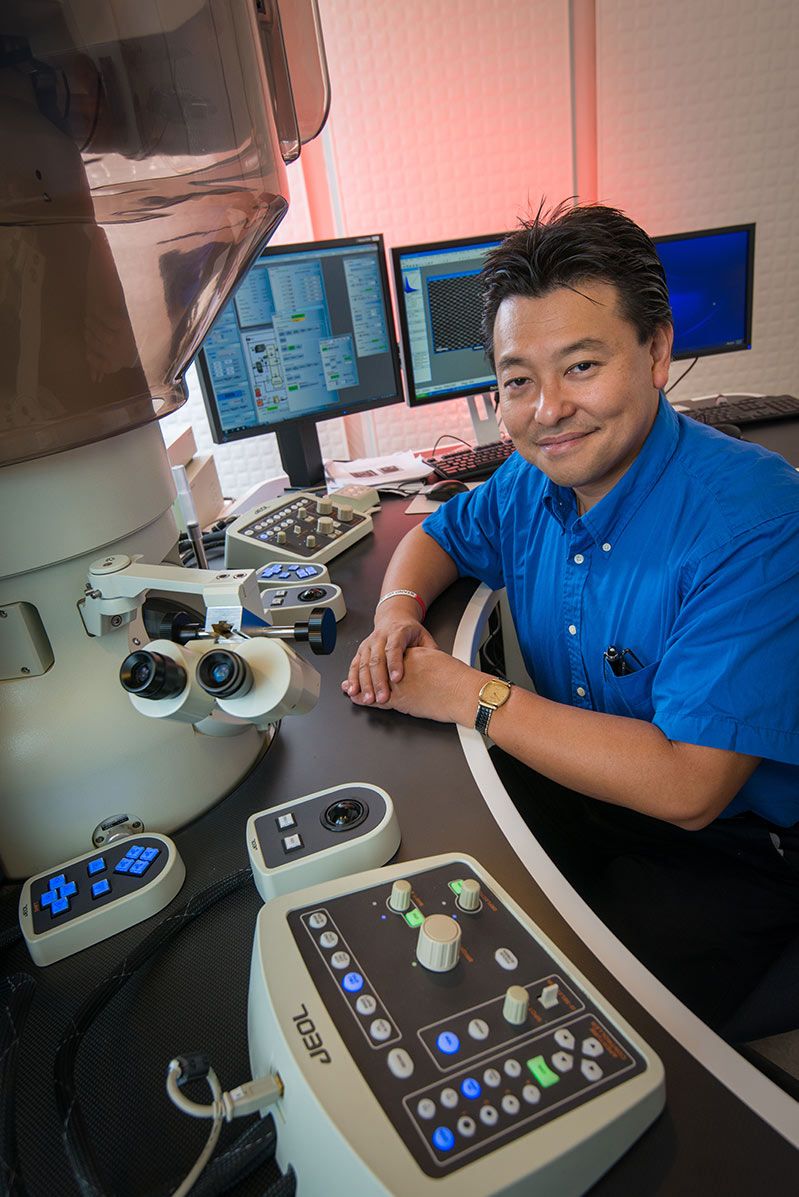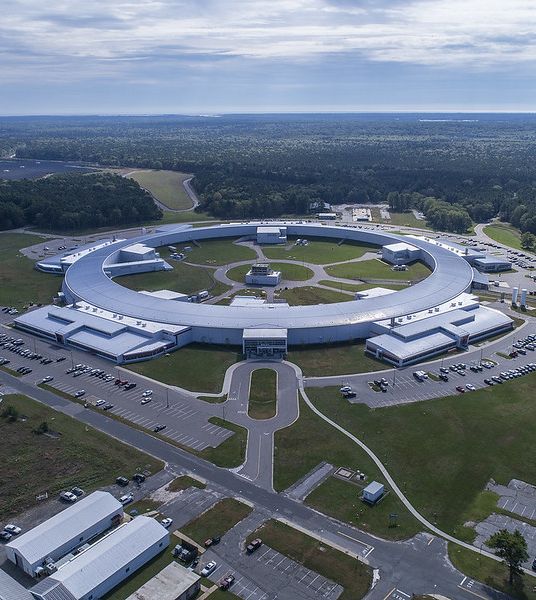Materials science researchers are developing novel instrumentation that could outperform synchrotron-based x-ray absorption spectrometry in giving scientists a clearer picture of elemental composition and chemical bonding at the nanoscale level
Lehigh University researchers are transforming an aberration-corrected scanning transmission electron microscope (STEM) into the equivalent of a synchrotron facility (a football-field-size particle accelerator), with greatly improved spatial resolution and versatility.
This upgraded instrumentation system, which integrates an electron energy loss spectrometer (EELS) into the aberration-corrected STEM (an approximately 3-meter-tall instrument, located on the first floor of Whitaker Laboratory) would expand scientists’ ability to characterize the chemical composition and bonding status of elements within a material down to the single-atom level, says Masashi Watanabe, an associate professor of materials science and engineering in the P.C. Rossin College of Engineering and Applied Science.
In electron energy loss spectrometry, a thin sample of a material is hit with the powerful electron beam of an electron microscope. EELS measures the changes in kinetic energy of electrons as they interact with the sample, which allows scientists to determine the elemental composition and to interpret chemical bonding status of materials. The technique is an alternative to the use of synchrotron-based x-ray absorption spectrometry, but current implementations at large-scale facilities can’t offer information at the nanoscale.
“Even at the national labs’ powerful synchrotron facilities, there is no instrument available that can get this high spatial-resolution information, this level of detail at the nanoscale, that we’re targeting,” says Watanabe. “That’s why, with a successful prototype of this novel EELS system that meets our goal of increasing spatial resolution by 1000 times over current integrations, we see important applications in areas like semiconductors, advanced alloys, and catalysis—and the potential for an overall paradigm shift.”
It’s an advance, he says, that could usher in a new era in materials characterization.
The Lehigh team is partnering with Japanese electron microscope manufacturer JEOL and German electron optics company CEOS to create the prototype, beginning in December 2020. It will include an EELS spectrometer with improved optics design for the detection of higher energy-loss electrons and an ultra-high sensitivity electron detector for limited signal detection in the high-energy-loss range. Current EELS spectrometers cannot detect energy-loss electrons higher than 3,000 eV; the new system will have capabilities up to ~13,000 eV.

Figure: An atomic-resolution image from a complex oxide (SrTiO3/LaMnO3) multilayer sample obtained by an aberration corrected scanning electron microscope (top). Atomic-resolution elemental distribution maps (middle and bottom) from the green boxed area in the top image showing the SrTiO3 part and LaMnO3 part, respectively. Both maps are created by color overlay with assigned RGB colors.
Images produced using EELS, like the example above, help scientists better understand elemental distributions within materials at the atomic scale and interpret their chemical bonding status. Lehigh researchers are developing a novel instrumentation system that will improve upon existing EELS technology.
The system will include a multifunctional scan generator for flexible electron probe control. In addition, the Lehigh team will develop an integrated software platform to efficiently control data acquisition while maintaining high spatial resolution and allowing energy-filtered imaging. Watanabe expects to gather elemental distributions at the atomic scale (as shown in the example figure of electron energy-loss images from a complex oxide multilayer sample) once the system development is completed. This instrument controlling scheme has been developed through the Presidential Nano/Human Interface Initiative (NHI) led by Martin Harmer, Alcoa Foundation Professor in the Department of Materials Science and Engineering.
The project was recently awarded a three-year, $625,000 grant from the National Science Foundation’s Major Research Instrumentation Program, which supports the development of next-generation research instruments and the creation of new opportunities for scientific and engineering discovery and collaboration.
Watanabe, who is one of the organizers of the Lehigh Microscopy School (an annual program that educates participants from industry, government, and academia in state-of-the-art scanning electron microscopy), is leading the system’s development. Fellow materials science and engineering faculty members Helen Chan, Himanshu Jain, John DuPont, and Christopher Kiely are co-PIs on the project and will test the instrumentation in their various research areas. The proposal was coordinated through Lehigh’s Institute for Functional Materials and Devices (I-FMD).
“We’ll be able to expand the materials we can investigate through EELS analysis to include, for example, gold nanoparticles in catalytic applications, high entropy alloys with heavy elements, and rare-earth based LEDs, among other applications,” Watanabe says. “It will give Lehigh a unique capability in materials characterization research and give researchers an alternative to traveling to a national synchrotron lab. We’re also advancing the educational mission of the Lehigh Microscopy School in training scientists and engineers from other institutions on new technology and ways to acquire data.”
About Masashi Watanabe
Masashi Watanabe is an associate professor of materials science and engineering in the P.C. Rossin College of Engineering and Applied Science at Lehigh University.
His research emphasizes materials characterization using various electron microscopy approaches involving analysis via X-rays and energy-loss electrons in analytical electron microscopes (AEMs) and atomic-resolution high angle annular dark-field (HAADF) imaging in scanning transmission electron microscopes (STEMs). He developed the zeta-factor method for quantitative X-ray analysis and implemented multivariate statistical analysis (MSA) for spectrum images of X-rays and energy-loss electrons.
Watanabe is affiliated with Lehigh’s Materials Characterization Facility as an associate director under the Institute for Functional Materials and Devices (I-FMD) and has served as an organizer and lecturer for the world-renowned Lehigh Microscopy School since 2001. He has been a lecturer in for other microscopy schools, including the Arizona State University Winter School on High Resolution Electron Microscopy (since 2008) and the Nano Science Education Program in Osaka University in Japan (since 2015). He served as a president of the Microanalysis Society (2016-2018) and is a Fellow of the Microanalysis Society (2019) and the Microscopy Society of America (2020).
Watanabe has more than 250 research publications in scientific journals and conference proceedings, and has given more than 150 invited presentations and seminars at numerous conferences and institutions. He is the recipient of numerous awards, including the K.F.J. Heinrich Young Scientist Award from the Microbeam Analysis Society (2005), the Kazato Prize from the Kazato Research Foundation (2008), and the Seto Award (the Society Award) from the Japanese Society of Microscopy (2011).


